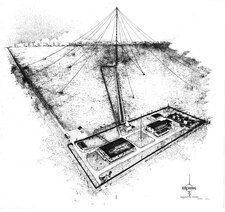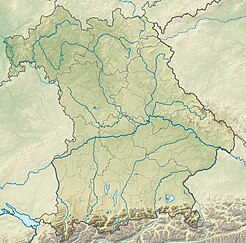Transmitter Erching
|
Transmitter Erching
|
||
|---|---|---|
| Basic data | ||
| Place: | Erching ( Hallbergmoos ) | |
| Country: | Bavaria | |
| Country: | Germany | |
| Altitude : | 465 m above sea level NHN | |
| Coordinates: 48 ° 17 ′ 56.4 " N , 11 ° 42 ′ 57.7" E | ||
| Use: | Broadcasting station | |
| Demolition : | 1989 | |
| Mast data | ||
| Construction time : | 1952-1953 | |
| Building material : | steel | |
| Operating time: | 1953-1989 | |
| Total height : | 256 m | |
| Data on the transmission system | ||
| Waveband : | LW transmitter | |
| Radio : | LW broadcast | |
| Shutdown : | 1989 | |
| Position map | ||
|
|
||
The Erching transmitter was a long-wave transmitter that was built between 1952 and 1953 near the Hallbergmoos district of Erching. He used as a transmission antenna 256 meters high, against earth insulated guyed lattice steel mast with roof capacity and he was at the time of its commissioning in 1953 with a transmitter power of 1000 kW, the most powerful radio station in the world.
At the time, the Erching broadcaster mainly broadcast the Voice of America program for the Eastern European countries. However, the RIAS program was also distributed at times .
It was broadcast on the frequency 173 kHz. In order to make the reception of the Erching station more difficult, some radio transmitters (no jammers) were put into operation on this frequency, some of which are still broadcasting today.
A special feature was the power supply of the station. It took place with the help of its own generators, since all transmission devices were designed as American devices for a supply of three-phase / alternating current with 60 Hertz and a converter or converter was apparently too expensive for the American operators. For this reason, the station building had large characteristic oil tanks, which gave the whole complex the appearance of an oil refinery. It was only when the Deutsche Bundespost took over the station that a converter was installed and the power supply switched to the supply from the public network.
Until recently, transmitters were used in which the modulation was carried out according to the Doherty method. These devices were efficient, but sometimes required a lot of coordination. When the frequency had to be reduced by 2 kHz in 1988 (from 209 kHz to 207 kHz), the transmitter was out of service for two days.
In 1973 the Erching transmitter was shut down as part of the policy of détente, but was reactivated in 1979 for tests of the LORAN -D radio navigation system . As part of the Geneva wave plan , the Deutsche Bundespost at the time managed to obtain the long-wave frequency of 209 kHz (from 1988: 207 kHz) for this station and to use the Erching station for broadcasting the Deutschlandfunk program . Since directional radiation had to be used during the night to use this frequency due to the requirements of the Geneva Wave Plan and because the new Munich airport, which is currently under construction, no second antenna carrier could be installed, this transmitter had to be switched off at night.
For this reason they looked for a new location for the transmitter and found it in 1985 near Aholming . With the commissioning of the Aholming transmitter, the Erching transmitter was shut down and dismantled.
Today the site is privately owned and is marketed for film and photo shoots.


